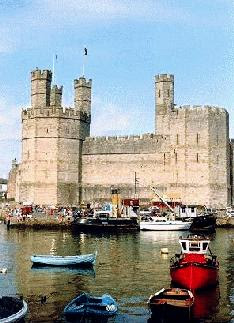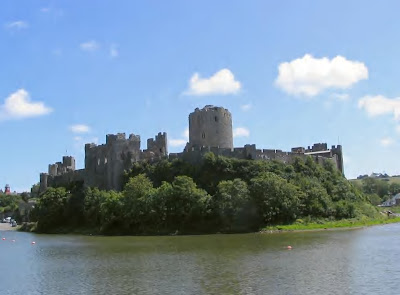The British Union Jack carries no Welsh emblem.

Drag pointer slowly OVER images for maximum effectiveness(with Left Hand Mouse button down))...
Cistercian Abbey of Tintern..Chepstow Wales



Castell Caernarfon in Wales


Pembroke Castle,Pembrokeshire in Wales
Can you in detail,if necessary, provide the origin and history of your countries flag...Other county folk will probably not agree,but what makes you so think it is such.
Does the appearance of your National flag provide shivvvvvers down the spine..What does one feel when your "country anthem" is played at events... football,rugby games etc
Wales is an integral part of the British Kingdom, yet it is not represented on the national flag, the Union Jack. The standard of Wales consists of a red dragon on a green and white background. As such, it will not fit easily into the design of the Union flag, composed of the red upright cross of "St. George" on a white background; the white diagonal cross of "St. Andrew" on a blue background; and the red diagonal cross of "St. Patrick" [Patrick was actually a Welshman) on a white background....However nothing to represent St David ..patron Saint of Wales
St David's Cathedral Wales
This represents England, Scotland and Ireland respectively. St. Andrew's Cross was added to the English flag in 1707 when Scotland joined the Union. The Union Jack that was flown in the American Colonies before the Revolution does not include the red diagonal of Ireland which was added in 1800 (and which remained after 1921, when Ireland was divided into the Free State and Ulster, or Northern Ireland, and seemingly unknown to BBC announcers). The red dragon of Wales(Y Ddraig goch) goes back a long time, long before the Union Jack was ever put together. As a national symbol for Wales, it predates its adaptation by the Tudors. The dragon is perhaps the very first mythical beast in British heraldry. Legend has Macsen Wledig and his Romano-British soldiers carrying the red dragon (Draco) to Rome on their banners in the fourth century. It was adopted in the early fifth century by the Welsh kings of Aberffraw to symbolize their authority after the Roman withdrawal. By the seventh century, it was known as the Red Dragon of Cadwallader, forever after to be associated with the people of Wales. The ninth century historian Nennius mentions the red dragon in his Historia Brittonum and it was referred to by Geoffrey of Monmouth in his Historia Regum Britanniae written between 1120 and 1129. In Geoffrey's account,Uther Pendragon was the father of Arthur; his name translates  as Dragon Head. Uther dreamed of a dragon appearing in a comet.
as Dragon Head. Uther dreamed of a dragon appearing in a comet.
When he became king, he had two dragon standards made. It was Geoffrey of Monmouth who told the tale of two dragons fighting, the red and the white, representing the Welsh and the English respectively. The red dragon is overthrown by the white one, signifying English control of Britain. The red dragon banner, however, continued to fly proudly; it was used by the Normans in Britain and apparently was used as the British standard at the Battle of Crecy (1346), in which Welsh archers, dressed in their beloved green and white, played so prominent a part. In the 15th century (though some sources give an earlier date, it may have been during this battle that the tradition of wearing a leek began).
Though Owain Glyndwr had raised his dragon standard in 1400 as a symbol of revolt against the English Crown, the dragon continued to be used by the Tudor monarchs. It signified their direct descent from one of the noble families of Wales. At Holywell, in Flintshire, there is a dragon carved over one of the arches beside St. Winifred's Well in honor of Henry VII, the first Tudor king. Henry's standard was white over green "with the red dragon over all." His eldest son, the Prince of Wales was to be the new King Arthur, uniting the whole of Britain, but he died before he could be crowned. During Henry VIII's reign the red dragon on a green and white background became a favorite emblem on many of the Royal Navy ships; it was also a particular favorite of Queen Elizabeth I "that red-headed Welsh harridan" as she has been called by historian A.L. Rowse. The dragon was replaced by a unicorn on the orders of James 1st, the Scot, not reappearing on the Royal Badge of Wales until 1807.
Quote.."In 1953,I was working in a large store in Rhyl, North Wales, when the news came that a new royal badge had been officially approved for Wales containing the motto: Y Ddraig Goch ddyry Cychwyn. A spirited discussion as to the translation brought forth "The Red Dragon Gives Impetus" as the best meaning, though "The Red Dragon gives a beginning or start" came close. (We settled for "The Red Dragon Inspires."....."
"As far as the national flag of Wales is concerned (the red dragon on a green and white background), it seems to have only come into prominence in the early part of the present century, being used at the 1911 Caernarfon Investiture of Edward, the Prince of Wales. Though the red dragon had reappeared as the royal badge for Wales in 1807, it wasn't officially recognized as the national flag of the principality until 1959. The Queen was successfully petitioned for its national use by the Gorsedd Beirdd Ynys Prydain (the Gorsedd of Bards of the Isle of Britain). Controversy over the correct version of the flag was settled that year when a statement from the Minister of State for Wales announced that "...only the Red Dragon on a green and white flag...shall be flown on Government buildings in Wales, and, where appropriate, in London." The Red Dragon now flies proudly over public and private buildings all over Wales and appears on all the "Welcome to Wales" (Croeso i Gymru) signs at the various border crossings. It has endeared itself to the Welsh people as a symbol of pride in their history and their hopes for their future."
Part author and images by Troedyrhiw
Labels: Cistercian Abbey, cymri, Cymric, David Kelly, Nennius, St. Mary the Virgin, Wales, Welsh



0 Comments:
Post a Comment
If its worth a comment,please think about it... good or bad...before you commit yourself.
<< Home